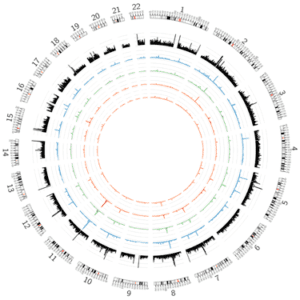Written by Nascent Transcript writer Sandra Smieszek
August 2018

Provided by Sandra Smieszek.
Longevity–an individual’s lifespan under ideal conditions–and healthy aging are among the most complex phenotypes studied to date. Human lifespan varies greatly, with life expectancy ranging from 47.5 in Sierra Leone to 79.8 in the United States and 87.2 years in Monaco. Currently, the world is home to around 500,000 people aged 100 and up–a number that is predicted to nearly double with each coming decade (Barbi et al., 2018). While there are environmental determinants of longevity such as diet, exercise, and stress, studies are identifying more genetic factors associated with it. Both our understanding of the factors affecting longevity and our ability to predict lifespan are improving, thanks to data collection efforts and access to large genomic datasets.
Several recent efforts have been made to predict lifespan and understand longevity and healthy aging. Two such recent studies are particularly noteworthy. In a preprint by Liu et al., ‘phenotypic age’ is predicted using nine blood biomarkers that are used to calculate the biological age of a person’s body–that is, how old a body seems from the way it functions, as opposed to how long it has been out of the womb. These nine biomarkers include albumin, creatinine, glucose, C-reactive protein, lymphocyte percent, mean cell volume, red blood cell distribution width, alkaline 2 phosphatase, and white blood cell count together with chronological age. Phenotypic age was significantly associated with all-cause mortality and cause-specific mortality (the predictive accuracy was 88% for all-cause mortality), even among seemingly “healthy” participants. Risk stratification by this composite measure was far superior to that of the individual biomarkers alone.
In another preprint by Timmers et al., the investigators performed a genome wide association study (GWAS) of survival in the UK Biobank and LifeGen datasets by assessing associations between genotype, parental lifespan, and mortality risk factors from one million participants. They estimated the heritability of lifespan to be 16.1% (SE = 0.4%). The extent to which lifespan can be explained by additive genetic variation has been widely debated, in part because the only consistent longevity associations emerging from GWAS data include variants within the APOE and FOXO3 genes. The Timmers et al. investigation replicated these loci and identified novel ones such as ABO and LDLR. Disease loci explaining the most lifespan variance were primarily associated with neurological disease, cardiovascular disease, and lung cancer, with cardio-protective variants being associated almost exclusively with increased lifespan. Interestingly, Timmers et al. also calculated a polygenic risk score (PRS) and found an increase in lifespan of 0.8–1.1 years with one standard deviation increase in the PRS.
Human lifespan is a complex trait that is not only influenced by genetic mechanisms, but also by the environment and gene–environment interactions. The effect of environment on lifespan has been demonstrated by studies that found associations between lifespan and zip codes (Dwyer-Lindgren et al., 2017). Non-genetic factors, particularly lifestyle, clearly affect the development of age-related diseases as well as health and lifespan in the general population.
To fully understand the desirable phenotypes of healthy aging and longevity, many factors need to be taken into account. On an optimistic note, risk of death–which, throughout most of life, seems to increase as people age–levels off after age 105, creating a ‘mortality plateau’ as recently reported in a Science publication (Barbi et al., 2018). Further, a recent study found that the ‘senolytic cocktail’, consisting of dasatinib and quercetin, extended life and health-span in mice (Xu., et al., 2018). These recent studies push the boundaries of our understanding of longevity and offer new insights into the human lifespan. With the continual and exponential increase in the number of large genomic datasets linked to electronic health records, future studies will hopefully continue to unravel the complexities of the human lifespan.
